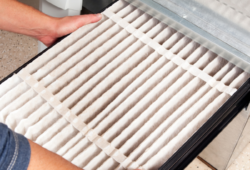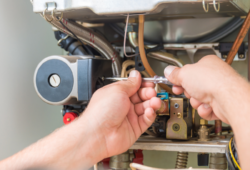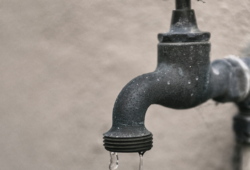Programmable Thermostats: With Proper Usage, You’ll Save Big
A programmable thermostat can be an effective tool in your efforts to save energy and reduce your utility bills. With a programmable thermostat, you can fine-tune your furnace and air conditioning temperature settings to match your family’s comfort needs throughout the week.

Programmable thermostats enable you to set your heating and air conditioning systems so that they automatically reduce your energy consumption at night or during times when your family is not at home. They will turn your furnace or heat pump setting down and your air conditioning setting up at appropriate times to save energy, and then return the settings to normal operating levels during times when your family is at home and awake.
For example, your family might prefer to have your house relatively cool on hot summer evenings while they’re watching television or surfing the Web, but there is no need to keep the house that cool during the day when everyone is at work. So, you might set your thermostat to keep your house at 85 degrees F. during the middle of the day, then automatically turn the A/C on in the late afternoon so that your house is a comfortable 78 degrees by the time everybody gets home in the late afternoon.
You can achieve similar energy savings without programmable thermostats if you can remember to change your thermostat settings manually at all the appropriate times. Even if you have a perfect memory, though, programmable thermostats have an advantage in that they can change your A/C and heat settings while you are asleep or away from home so that your house is back to its normal temperature when you wake up in the morning or get home from work.
Choosing Programmable Thermostats
Programmable thermostats are available in a wide variety of styles and functions. Ask your HVAC contractor to help you pick a model that is compatible with your heating and air conditioning systems and the existing thermostat wiring. If you follow the written instructions carefully, most thermostat installations are simple, but call for help if you get confused about which wires go where when you’re replacing your old manual thermostat with a programmable model.
Choose a model that is flexible enough to allow you to program as many individual settings as you need to fit your lifestyle. Some models can be programmed for different settings for each day of the week, while simpler models can be programmed for the same settings for five weekdays with different settings on the weekend days.
Some programmable thermostats offer basic temperature controls and little else, while more expensive models have special features such as indicator lights that remind you when it’s time to change your HVAC air filter. Some thermostats get their power from your home’s electric wiring and some are battery operated, so be sure you know if you need to change batteries on a regular schedule to keep your HVAC systems running.
If you have a heat pump, you will need to select a thermostat that is specifically designed for heat pump operation. These special thermostats are designed to detect the most efficient heating set-backs to save energy without having the expensive electric resistance backup heating kick in when it’s time to bring the temperature back up to normal.
Using Programmable Thermostats
A typical strategy for using programmable thermostats for energy savings would be to set your air conditioning at around 78 degrees F. and your furnace at around 68 degrees F. for the times when your family is home and active. You would then program your thermostat to set your heat back by eight to 10 degrees and your A/C up by a similar amount late at night and during the day when your house is not occupied.
Here are a few tips for varying the typical strategy so that you save even more money on your heating and cooling bills:
- Avoid manually overriding your programmed temperature settings. It may be tempting to briefly set your A/C colder when you first come in from working in the yard on a hot summer day or to turn the heat up after you come inside from walking the dog on a cold, damp winter day, but you will use less energy if you let your system do its job automatically without overshooting its preset temperatures.
- Set the night-time A/C temperature up by more than 10 degrees and use ceiling fans to keep the air moving. Turn off the A/C and open windows to take advantage of natural circulation of cooler night air.
- Set your heat back more than 10 degrees at night and during regularly scheduled times when nobody is at home. Many people prefer sleeping in chilly bedrooms with extra blankets for particularly cold nights. With our relatively mild North Carolina winters, you may find that your house stays reasonably comfortable at night even if you set the thermostat back 20 degrees or more and your furnace does not turn on until early morning.
- Don’t be too aggressive with heat set-backs. Be aware that if you have a heat pump, aggressive winter set-backs can actually cost you more due to the operation of the electric resistance backup heating coils. Also, letting your house get too cold on harsh winter nights could lead to expensive problems like frozen water pipes, so balance your desire for energy efficiency against the other costs that might be caused by trying too hard to save energy.
- If you have zoned heating and cooling, set thermostats differently for each zone. You can save energy by customizing the settings for each part of your house based on the activities the areas are used for. For example, your kitchen and other areas where people stay active may not need as much heat in the winter as the family room where people watch TV.
- Choose the right location for your thermostat. Your thermostat should be located in an area that’s not affected by sunlight or drafts that might cause it to read temperatures that do not match the actual temperatures in your home’s living areas. Placement on an inside wall away from air supply and return ducts or sources of heat such as kitchen appliances or fireplaces will give the most accurate temperature control for your HVAC systems. The thermostat should not be blocked by draperies or furniture that might interfere with the free movement of conditioned air around its sensors.
- Consider your thermostat to be just one part of a larger system. If you view your entire house as being a single energy handling system, you can find ways to save energy beyond just managing temperatures with your thermostat. Investments in attic insulation, duct repairs and sealing air leaks can reduce energy losses and keep your home more comfortable in every season. The more you can reduce winter heat loss and summer heat gain, the less often your heating and air conditioning systems will have to come on to maintain your set temperatures and the more you will save on your utility bills.
Call your Air Experts with any questions you may have about programmable thermostats or for help choosing or installing the right model for your Triangle area home.
Image Provided by Shutterstock.com




